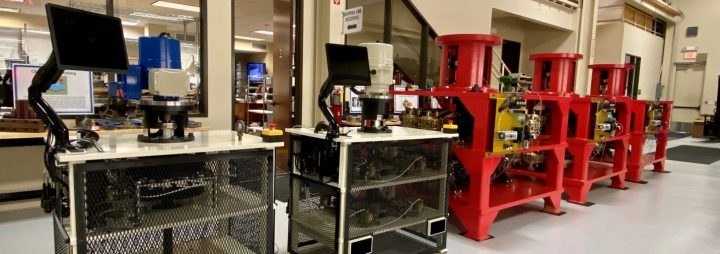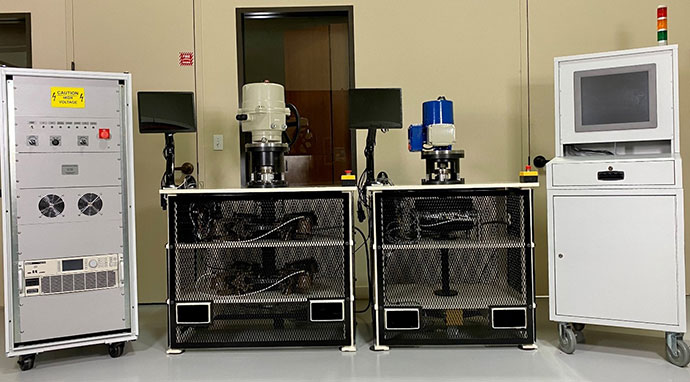Fully Integrated Actuator Test Stands

Kalsi Engineering specializes in designing, manufacturing, and assembling actuator test stands that fully integrate with processes in existing production cells or refurbishment centers. The KEI design team custom designed and fully integrated two torque benches, a common control cabinet, and a power supply cabinet (see Figure 1) in a production cell for an actuator manufacturer. The test stands are used to verify function and capability of motor-operated actuators.
Test Stands
The two test stands were designed with different torque capacities to cover the range of actuator output torque of the product line. The large test stand is capable of 25,000 in-lbf and the small test stand is capable of 5,000 in-lbf. Each test stand is equipped with quick-install torque cells, an absolute encoder, several solenoid valves used to activate brake calipers, and an electronic regulator to control the brake torque. The quick-install torque cells allow for easy removal of the instrument for calibration or easy exchange with a torque cell of a different span for improved accuracy. Each test stand is equipped with a RFID (radio frequency identification) card reader, barcode scanner, touch screen monitor, and an emergency stop button.

KEI Designed two torque benches, a control cabinet, and a power cabinet for use in a new-build production cell. The test stands are used to verify actuator function and capacity.
Software and Test Controls
The test stand software was developed to control the entire actuator test sequence. The test process is initiated when a technician scans his identification card. Once the technician has been authenticated with the test program, the program waits for the technician to scan the actuator serial number barcode. The program uses the barcode to retrieve the actuator product code from the customers database. The product code is used to establish the test requirements including actuator capability, actuator controls and interfaces, and other actuator features and functions to be tested. Based on the product code, the test program provides the technician with test setup information including the identifier for the actuator wire harness and the shaft adapter. The program and the actuator wire harnesses are designed so that the program can verify that the proper harness was selected and installed before power is provided to the actuator.
Once the actuator is secured and properly connected, the program automatically performs the required sequence of tests including torque switch trip verification, local control verification, and backup power verification. The torque applied during each test is controlled by the program based on the actuator rated torque and the user-defined torque profile.
After completing the test matrix, the program reviews the results of each test and performs an evaluation of the actuator performance. The program logs the technician’s name, actuator serial number, key test results, and actuator acceptance review results in a SQL database.
Power Cabinet
The power cabinet that is integrated into this system is capable of supplying DC, single-phase AC, split-phase AC, and 3-phase AC. Voltage can be supplied at 50 Hz or 60 Hz with very low harmonic distortion. The power cabinet controls are fully integrated with the control cabinet allowing the test program to set the required voltage, and phase rotation for 3-phase applications. The power cabinet is instrumented to measure voltage, RMS current, instantaneous current, frequency, and power factor.
Click here to contact KEI and learn more of what our design team can do for you!
